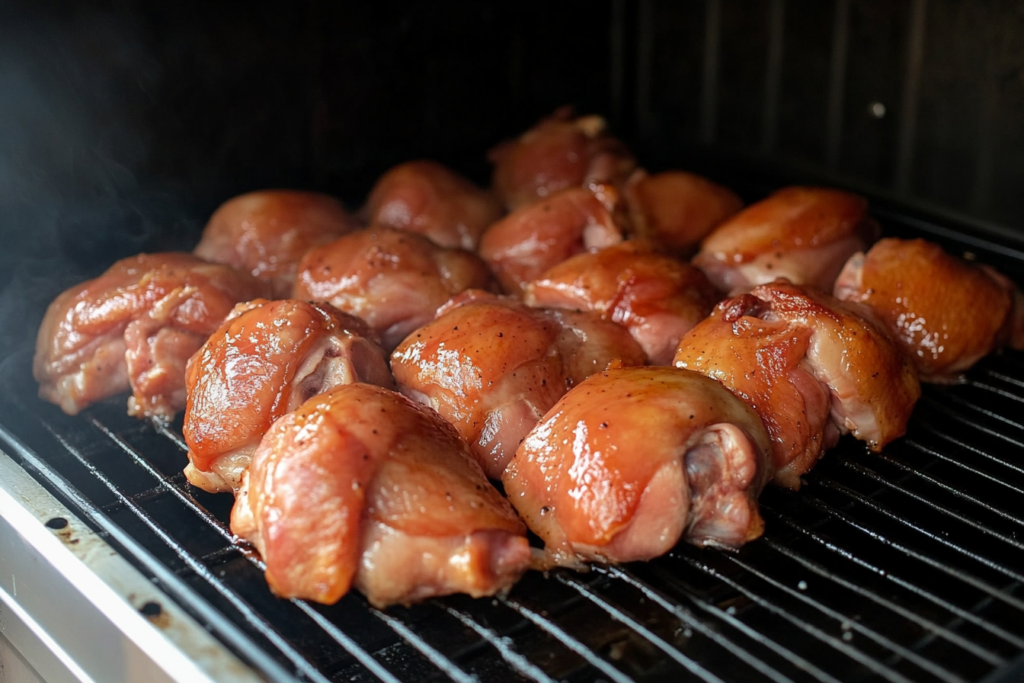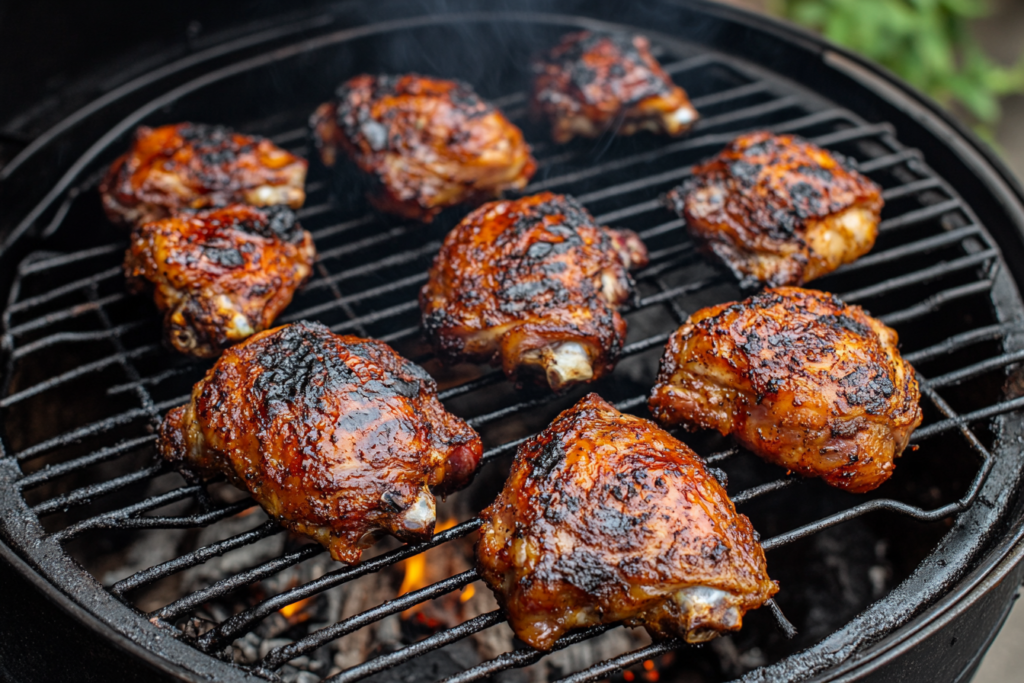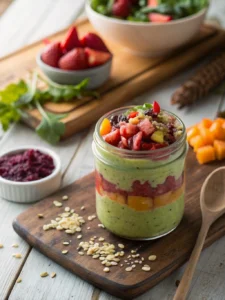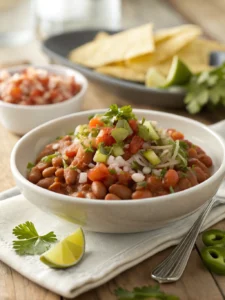Introduction
Did you know that chicken thighs contain nearly twice the iron and zinc of chicken breasts, yet most home cooks still default to the less flavorful white meat? If you’re looking to elevate your backyard cooking game, smoked chicken thighs are the perfect place to start. These Traeger smoked chicken thighs deliver incredible flavor with minimal effort, making them ideal for both weeknight dinners and weekend gatherings. The combination of naturally juicy dark meat with the Traeger’s consistent temperature control creates chicken that’s tender inside with perfectly crispy skin outside.
Ingredients List
For these mouthwatering smoked chicken thighs, you’ll need:
- 8 bone-in, skin-on chicken thighs (approximately 3-4 pounds)
- 2 tablespoons olive oil or avocado oil
- 3 tablespoons of your favorite BBQ rub (I recommend a mix with brown sugar, paprika, garlic powder, onion powder, salt, and pepper)
- 1 cup of your preferred BBQ sauce (optional for basting)
- 1 tablespoon apple cider vinegar (helps tenderize the meat)
- 2 cloves minced garlic (for extra flavor depth)
Substitution options:
- Boneless thighs work well but reduce cooking time by about 15 minutes
- For a healthier option, use a salt-free herb rub and skip the BBQ sauce
- Coconut oil can replace olive oil for a subtle flavor variation
- For a spicier version, add 1 teaspoon of cayenne pepper to your rub
Timing
- Preparation Time: 15 minutes (including trimming and seasoning)
- Preheating Grill: 15 minutes
- Cooking Time: 90 minutes (25% less than traditional oven methods)
- Total Time: 2 hours
Table of Contents
Step-by-Step Instructions
Step 1: Prepare the Chicken Thighs
Trim any excess skin and fat from the chicken thighs, but leave most of the skin intact as it will render down and create amazing flavor. Pat the thighs dry with paper towels—this crucial step ensures crispy skin and better smoke adhesion. Drizzle both sides with oil and massage it evenly over the surface.
Step 2: Season Generously
Apply your BBQ rub liberally to all sides of the chicken thighs, pressing gently to adhere. For maximum flavor development, season the meat at least 30 minutes before cooking or, even better, let it sit in the refrigerator overnight. This dry-brining process allows the salt in your rub to penetrate deeper into the meat.
Step 3: Preheat Your Traeger
Set your Traeger pellet grill to 225°F and allow it to preheat fully with the lid closed for 15 minutes. For this recipe, fruit woods like apple or cherry work exceptionally well, providing a subtle sweetness that complements the chicken without overpowering it.
Step 4: Smoke the Chicken Thighs
Place your seasoned chicken thighs on the grill grates skin-side up, spacing them evenly to allow proper air circulation. Close the lid and smoke at 225°F for 45 minutes. This low-and-slow initial cooking allows the smoke flavor to penetrate deeply while beginning to render the fat under the skin.
Step 5: Increase the Temperature
After 45 minutes, increase your Traeger’s temperature to 350°F. This temperature transition is the secret to achieving that perfect balance—tender, juicy meat with crispy, bite-through skin. Continue cooking for another 30-45 minutes until the internal temperature reaches 175°F in the thickest part.
Step 6: Apply BBQ Sauce (Optional)
When the chicken reaches 165°F, brush your favorite BBQ sauce on the skin side if desired. This creates a delicious glaze as the thighs finish cooking. Only apply sauce at this stage—adding it earlier can cause burning due to the sugar content.
Step 7: Rest Before Serving
Remove the chicken thighs from your pellet smoker when they reach 175°F internal temperature. Let them rest uncovered for 5-10 minutes before serving. This resting period allows the juices to redistribute throughout the meat, ensuring maximum moisture retention.

Nutritional Information
Per chicken thigh (based on average 5oz thigh with skin):
- Calories: 275
- Protein: 22g
- Fat: 19g
- Carbohydrates: 3g (varies based on rub/sauce)
- Sodium: 440mg
- Iron: 1.5mg (8% DV)
- Zinc: 2.4mg (22% DV)
*Values may vary based on specific ingredients and portion sizes.
Healthier Alternatives for the Recipe
Transform these smoked chicken thighs into a more nutritious meal with these simple modifications:
- Remove the skin after cooking to reduce fat content by approximately 30%
- Use a salt-free herb rub with smoked paprika, garlic powder, and herbs
- Skip the BBQ sauce and finish with a squeeze of fresh lemon for brightness
- Use boneless, skinless thighs (though they won’t be quite as juicy)
- Add a tablespoon of Greek yogurt to your rub for tenderizing without extra oil
- Serve alongside grilled vegetables instead of traditional starchy sides
Serving Suggestions
Elevate your smoked chicken thighs with these complementary sides and presentation ideas:
- Create a Southern-inspired meal with creamy coleslaw and cornbread
- Serve over a bed of cilantro-lime rice with grilled corn
- Pair with a bright, acidic side like vinegar-based potato salad to balance the rich meat
- For a low-carb option, serve alongside roasted vegetables or a fresh garden salad
- Slice the meat off the bone and use in tacos with fresh pico de gallo
- For entertaining, arrange on a platter with charred lemon halves for squeezing and fresh herbs as garnish
Common Mistakes to Avoid
Even experienced grillers can improve their chicken thigh game by avoiding these common pitfalls:
- Cooking at too high a temperature: This causes the fat to render too quickly, resulting in flare-ups and burnt skin before the interior is done.
- Removing the thighs too early: Unlike chicken breast, thighs benefit from cooking to 175°F rather than just 165°F. This extra time breaks down connective tissue for a better texture.
- Not trimming excess skin: While skin is desirable, excess flaps can burn and create bitter flavors.
- Applying sauce too early: Sugar-based sauces burn easily; only apply in the final 15 minutes of cooking.
- Overcrowding the grill: Chicken thighs need space for proper air circulation and even cooking.
- Constant lid opening: Every peek adds 5-10 minutes to your cooking time and causes temperature fluctuations.
Storing Tips for the Recipe
Extend the enjoyment of your pellet grill chicken thighs with these storage recommendations:
- Refrigerate leftover chicken thighs within two hours of cooking in an airtight container for up to 4 days.
- For meal prep, smoke extra thighs and freeze individually wrapped portions for up to 3 months.
- Reheat refrigerated thighs in a 300°F oven for 15 minutes to maintain moisture and re-crisp the skin.
- Cold smoked chicken thighs make excellent additions to salads or sandwiches.
- For best flavor preservation, cool completely before storing and keep sauce separate if possible.
- If freezing, consider removing bones first for easier reheating and more compact storage.
Conclusion
These Traeger smoked chicken thighs deliver restaurant-quality results with their perfect balance of smoky flavor, crispy skin, and juicy meat. The two-temperature approach ensures ideal texture while the customizable rub allows you to create a signature taste that your family will request again and again.
Have you tried this smoked chicken thighs recipe? We’d love to hear about your experience in the comments section below! Don’t forget to subscribe for more pellet grill recipes and techniques delivered straight to your inbox.
FAQs
Q: Can I use boneless chicken thighs for this recipe? A: Absolutely! Boneless thighs work well but cook faster. Reduce the overall cooking time by about 15 minutes and aim for an internal temperature of 170-175°F for the best texture.
Q: My chicken skin isn’t getting crispy. What am I doing wrong? A: Three likely culprits: not patting the chicken dry before seasoning, cooking at too low a temperature throughout, or too much humidity in your smoker. Try the two-temperature approach in this recipe for better results.
Q: Which wood pellets work best for chicken thighs on a Traeger? A: Fruit woods like apple, cherry, or peach provide a mild, sweet smoke that complements chicken perfectly. Hickory works well for a stronger smoke flavor, while mesquite might be too overpowering.
Q: How do I know when the chicken thighs are done? A: Always use a meat thermometer. While 165°F is technically safe, cooking thighs to 175°F breaks down connective tissue for a better texture. The meat should pull easily from the bone.
Q: Can I prepare these chicken thighs ahead of time? A: Yes! Season the thighs up to 24 hours in advance and refrigerate uncovered for drier skin. You can also fully cook the thighs, refrigerate, and reheat at 300°F for 15 minutes before serving.
Q: My Traeger doesn’t go up to 350°F. Can I still make crispy chicken thighs? A: Yes. Smoke at your grill’s maximum temperature, and if needed, finish the thighs under a broiler for 2-3 minutes to crisp the skin. Watch carefully to prevent burning.



